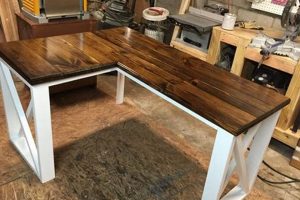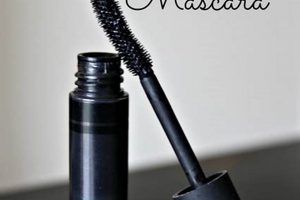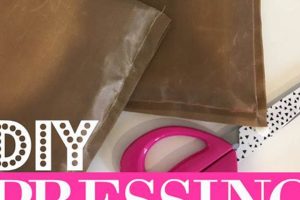A handcrafted method to create a fastener for writing instruments, utilizing tanned animal hide. This commonly involves cutting, shaping, and securing a strip of leather to a pen to allow it to be affixed to notebooks, pockets, or other surfaces. As an example, an individual might fashion a small loop of leather, stitching it to itself and then adhering or weaving it onto a pen’s barrel.
The practice offers several advantages. It provides a personalized alternative to commercially produced pen clips, allowing for customization in terms of size, color, and style. Further, it promotes sustainability through the resourceful use of leather scraps. Historically, leathercraft has been a valued skill, and this particular application represents a continuation of this tradition, adapting it to the needs of modern users of writing instruments.
The following sections will delve into specific techniques for crafting these leather attachments, examining the necessary tools and materials, and providing detailed instructions for several design variations. Considerations for leather selection and finishing techniques will also be addressed.
DIY Pen Clip Leather
This section provides practical guidance for crafting pen clips from tanned animal hide. Attention to detail and proper technique are crucial for a durable and aesthetically pleasing result.
Tip 1: Leather Selection: Opt for vegetable-tanned leather between 2-3 ounces in weight. This provides sufficient rigidity for clip function while remaining pliable enough for shaping and stitching.
Tip 2: Pattern Precision: Create accurate paper or cardstock templates before cutting leather. This minimizes material waste and ensures consistent sizing and shape across multiple clips.
Tip 3: Edge Finishing: Burnish the edges of the cut leather using a wooden slicker and beeswax. This seals the edges, preventing fraying and creating a smooth, professional finish.
Tip 4: Stitching Technique: Employ a saddle stitch for maximum strength and durability. Use waxed thread appropriate for leatherwork and maintain consistent stitch length and tension.
Tip 5: Adhesive Application: If using adhesive to secure the clip to the pen, choose a flexible contact cement specifically designed for leather. Apply thinly and evenly to both surfaces and allow to tack before joining.
Tip 6: Hardware Integration: When incorporating metal hardware, such as rivets or snaps, ensure proper setting using appropriate tools. Improperly set hardware can weaken the clip and damage the leather.
Tip 7: Pen Compatibility: Consider the diameter and material of the pen when designing the clip. Adjust the clip’s dimensions to ensure a secure and snug fit without damaging the pen’s surface.
These tips emphasize the importance of material selection, precise execution, and attention to detail. Following these guidelines will result in robust and aesthetically pleasing leather pen clips.
The subsequent sections will discuss advanced design techniques and offer troubleshooting advice for common crafting challenges.
1. Leather Selection
The choice of leather fundamentally dictates the success and longevity of any self-made pen clip. The material’s properties directly impact the clip’s ability to securely hold a pen, withstand daily wear, and maintain its aesthetic appeal. For example, using thin, garment-grade leather may result in a clip that quickly stretches or tears, rendering it ineffective. Conversely, excessively thick leather might prove too rigid, making it difficult to shape and attach properly. The selection process necessitates a balance between durability, workability, and aesthetic considerations.
Vegetable-tanned leather, typically between 2-3 ounces in weight, is often favored due to its inherent firmness and ability to hold its shape. This type of leather can be easily molded and tooled, allowing for customization of the clip’s design. Chrome-tanned leather, while softer and more pliable, may lack the necessary rigidity for secure pen retention. A practical illustration involves crafting a clip intended for a frequently used fountain pen. Opting for a high-quality, vegetable-tanned leather ensures the clip retains its grip over time, preventing accidental pen loss.
In conclusion, appropriate leather selection is not merely a preliminary step, but an integral component of the entire crafting process. Overlooking this aspect can lead to a substandard result, undermining the time and effort invested in the project. Therefore, a thorough understanding of leather types and their respective characteristics is essential for any individual undertaking the creation of a pen clip.
2. Clip Design
The configuration of a leather pen clip is paramount to its functionality and aesthetic integration with the writing instrument it is intended to secure. A well-conceived plan ensures proper pen retention, durability, and user comfort. The design phase is critical in determining the clip’s overall effectiveness.
- Retention Mechanism
The primary function of the leather pen clip is to firmly hold the pen in place. Design considerations include the degree of tension applied, the contact points between the clip and the pen, and the overall geometry that facilitates secure holding. For example, a simple loop design relies on friction, while more complex designs may incorporate strategically placed indentations or protrusions to enhance grip. Improper design can result in either inadequate retention, leading to pen slippage, or excessive force that damages the pen’s finish or structure.
- Material Compatibility and Integration
The design must account for the properties of leather, including its flexibility, thickness, and tendency to stretch over time. Additionally, the design should integrate seamlessly with the pen’s material and form factor. A clip designed for a thin metal pen barrel may be unsuitable for a thicker, resin-bodied pen. The fastening method, whether adhesive, stitching, or rivets, must also be considered to ensure a secure and aesthetically pleasing attachment. A design oversight in this area can compromise the clip’s structural integrity and visual appeal.
- Ergonomics and Usability
The clip design should not impede the user’s ability to comfortably hold and use the pen. A bulky or poorly positioned clip can create discomfort or interfere with the writing process. The ease of attaching and detaching the pen from the clip is another important ergonomic factor. A design that requires excessive force or manipulation can be frustrating for the user and increase the risk of damage to the pen or clip. Ergonomic testing and user feedback can be valuable in optimizing the design for usability.
- Aesthetic Harmony and Customization
The design of the clip should
complement the style and character of the pen. The clip’s shape, size, and finish can be tailored to create a cohesive and visually appealing accessory. Leather offers opportunities for personalization through tooling, carving, and dyeing, allowing for a unique and expressive design. However, an aesthetically incongruous design can detract from the pen’s overall appearance and diminish the perceived value of both the pen and the clip.
These facets collectively emphasize the profound impact of design on functionality, durability, and aesthetics. Careful consideration of these elements is essential for creating a leather pen clip that effectively secures the pen, enhances the user experience, and complements the overall presentation.
3. Stitching Technique
The method of stitching employed in the construction of a self-made pen clip from tanned animal hide directly influences its structural integrity, durability, and overall aesthetic appeal. The selected technique is not merely a functional necessity but an integral design element.
- Saddle Stitch Strength
The saddle stitch, characterized by two needles passing through each stitch from opposite directions, is often favored for its exceptional strength and resilience. If one stitch breaks, the others remain secure, preventing complete seam failure. This robustness is crucial in pen clips, which endure repeated stress from pen insertion and removal. For instance, a pen clip affixed to a frequently used journal, subjected to daily wear, benefits significantly from the security provided by the saddle stitch.
- Thread Selection Impact
The choice of thread, encompassing material and thickness, is intrinsically linked to the chosen stitching technique. Waxed thread, commonly used in leatherwork, provides added durability and resistance to abrasion. The thread’s thickness should be proportional to the leather’s weight to avoid compromising the structural integrity of the clip. As an example, utilizing a fine thread with thick leather could result in the thread breaking under stress, while an excessively thick thread might create unsightly and bulky seams.
- Stitch Consistency and Aesthetics
Maintaining consistent stitch length and spacing contributes significantly to the overall appearance of the crafted pen clip. Uniform stitches create a visually appealing and professional-looking finish. In contrast, irregular stitch patterns can detract from the clip’s aesthetic value and potentially weaken the seam. Consider a scenario where a pen clip is intended as a gift; neat and consistent stitching demonstrates attention to detail and enhances the perceived quality of the handcrafted item.
- Edge Stitching Considerations
The proximity of the stitching to the edge of the leather influences the clip’s resistance to tearing and fraying. Stitching too close to the edge can weaken the leather, increasing the likelihood of separation. Conversely, stitching too far from the edge may create an unnecessary and visually unappealing border. Proper edge distance, typically determined by the leather’s thickness, provides a balance between structural integrity and aesthetic presentation.
These facets of stitching technique collectively underscore their significance in the creation of a robust and visually appealing handcrafted pen clip. The deliberate selection and execution of a suitable stitching method are essential for ensuring the clip’s long-term functionality and aesthetic harmony with the intended writing instrument.
4. Attachment Method
The manner in which a self-fabricated leather pen clip is affixed to either the writing instrument or an accompanying item, such as a notebook, profoundly influences its functionality, security, and aesthetic integration. The selection of an appropriate attachment method is critical for ensuring long-term usability and preventing damage to both the clip and the object to which it is attached.
- Adhesive Bonding
The application of adhesives, specifically those designed for leather, provides a direct method of attachment. Contact cement, for instance, establishes a flexible bond that accommodates the natural movement of leather. However, the adhesive’s long-term durability and resistance to temperature variations must be considered. The use of inappropriate adhesives can lead to premature bond failure or damage to the leather or the pen’s finish. As an example, cyanoacrylate adhesives (super glues) are generally unsuitable due to their rigid nature and potential to cause discoloration.
- Stitching Integration
Incorporating the clip directly into the stitching of a leather notebook cover provides a robust and aesthetically cohesive attachment. This method involves strategically positioning the clip during the binding process, ensuring that the stitching secures it firmly in place. The strength of the stitching and the quality of the thread are paramount for long-term durability. An example is integrating the clip into the spine stitching of a journal, providing a secure and unobtrusive means of pen storage.
- Riveting and Hardware
The use of rivets, snaps, or other hardware provides a mechanical method of attachment. This approach is particularly suitable for thicker leathers or when a detachable clip is desired. Proper setting of the hardware is crucial to prevent loosening or damage to the leather. As an example, small brass rivets can be used to secure the clip to a pen loop attached to a briefcase, providing a secure and visually appealing attachment.
- Weaving and Slotting
Involving the weaving of leather strips, creating slots in the leather, or employing intricate techniques to secure the pen clip offers a unique attachment method. This technique ensures durability and creates a strong bond between the pen clip and the surface. A practical illustration is seen in leather journals, where a pen clip is meticulously woven through slits in the cover, preventing accidental pen loss while adding an aesthetic appeal.
These attachment methods represent distinct approaches to securing leather pen clips. The selection of an appropriate technique requires careful consideration of the materials involved, the intended use of the clip, and the desired aesthetic outcome. Each method presents unique advantages and limitations, necessitating a thorough evaluation to ensure the creation of a functional and durable finished product.
5. Durability Considerations
The longevity and resilience of a self-made pen clip, constructed from tanned animal hide, are paramount to its practical value. Addressing durability is not merely an afterthought but a central tenet in its design and fabrication. Failure to adequately consider these factors will result in a clip that quickly degrades, negating the time and resources invested in its creation.
- Leather Grade and Tannage
The selection of leather directly dictates the clip’s resistance to wear and tear. Vegetable-tanned leather, known for its density and ability to hold
its shape, typically offers superior durability compared to chrome-tanned alternatives. The specific grade of the leather, indicating the presence of imperfections or scarring, also influences its longevity. For instance, a clip crafted from full-grain vegetable-tanned leather will withstand significantly more stress and abrasion than one made from a lower grade split leather. - Stitching Integrity and Thread Quality
The strength of the stitching is critical in preventing the clip from separating under stress. A robust stitching technique, such as the saddle stitch, coupled with a durable thread, such as waxed linen or nylon, ensures that the clip remains intact even with repeated use. Inferior stitching or thread can lead to premature seam failure, rendering the clip unusable. As an illustration, a clip utilizing a lock stitch with cotton thread will likely unravel and degrade much faster than a saddle-stitched clip with waxed linen thread.
- Hardware Selection and Securement
If incorporating metal hardware, such as rivets or snaps, the quality and proper setting of these components are crucial. Corrosion-resistant materials, such as brass or stainless steel, prevent degradation over time. Furthermore, the hardware must be securely fastened to the leather to prevent loosening or detachment. For example, poorly set rivets can damage the leather and fail to adequately secure the clip, while corroded hardware can weaken the overall structure.
- Environmental Exposure and Protection
Exposure to environmental elements, such as sunlight, moisture, and extreme temperatures, can accelerate the degradation of leather. Applying a protective finish, such as a leather conditioner or sealant, can mitigate these effects and extend the clip’s lifespan. Neglecting to protect the leather can lead to drying, cracking, and discoloration. A pen clip exposed to direct sunlight for extended periods, without any protective treatment, will become brittle and prone to damage.
These facets collectively illustrate that the durability of a self-made tanned animal hide pen clip is a multifaceted consideration. Addressing each of these elements through careful material selection, meticulous construction techniques, and appropriate protection measures is essential for creating a clip that endures the rigors of daily use and provides lasting value.
Frequently Asked Questions
This section addresses common inquiries regarding the creation and application of leather-based pen retention devices crafted through do-it-yourself methods. The intent is to provide clear, concise answers to assist individuals in successfully undertaking such projects.
Question 1: What type of leather is most suitable for a lasting pen clip?
Vegetable-tanned leather, typically between 2 and 3 ounces in weight, offers the optimal balance of durability and workability. This material provides sufficient rigidity for secure pen retention and is amenable to shaping and tooling techniques.
Question 2: Which stitching method provides the greatest structural integrity?
The saddle stitch, characterized by the use of two needles passing through each stitch from opposing directions, provides superior strength and prevents complete seam failure should a single stitch break.
Question 3: Can adhesives be effectively employed for securing leather pen clips?
Yes, provided a flexible contact cement specifically formulated for leather is used. Proper surface preparation and adhesive application, following manufacturer instructions, are critical for a durable bond.
Question 4: How can the leather be protected from environmental damage?
Applying a leather conditioner or sealant provides a protective barrier against sunlight, moisture, and temperature fluctuations, mitigating drying, cracking, and discoloration.
Question 5: What considerations are important when integrating metal hardware?
Utilizing corrosion-resistant materials, such as brass or stainless steel, is essential. The hardware must be securely fastened to prevent loosening or damage to the leather. Proper setting techniques are crucial.
Question 6: How does design contribute to overall clip durability?
A well-conceived design accounts for the properties of leather, including its flexibility and tendency to stretch. The retention mechanism should provide secure pen retention without excessive force. Design also includes the degree of surface area in contact.
These responses highlight key considerations related to material selection, construction techniques, and maintenance practices. Addressing these factors is essential for creating durable and functional leather pen clips.
The following article section will address potential challenges and explore advanced customization options.
Conclusion
This article has provided a comprehensive examination of crafting pen clips from tanned animal hide. Key areas explored included material selection, clip design principles, stitching techniques, attachment methods, and durability considerations. The importance of careful planning and execution has been consistently emphasized throughout, highlighting the intrinsic link between each stage of the fabrication process and the final product’s quality and longevity.
The creation of a pen clip from tanned animal hide is an endeavor that calls for precision, creativity, and dedication to detail. While the information provided serves as a foundational guide, the ongoing exploration of new techniques and materials is encouraged. It is through this continuous pursuit of refinement that true mastery of the craft is achieved.Therefor, it is expected that knowledge and experiences can be share to future craftsment for better “diy pen clip leather”.







